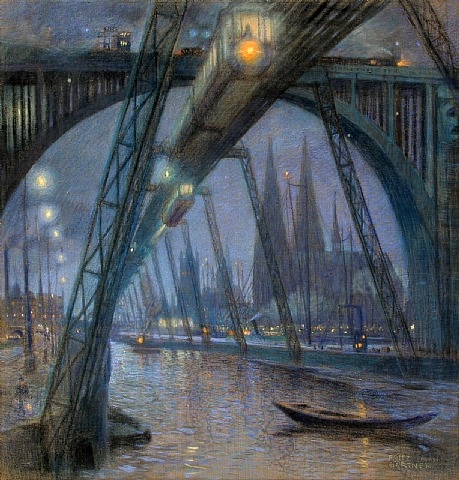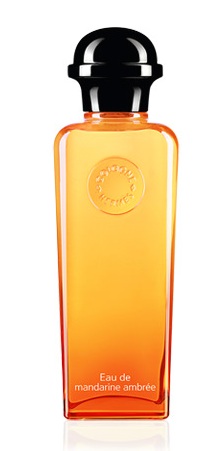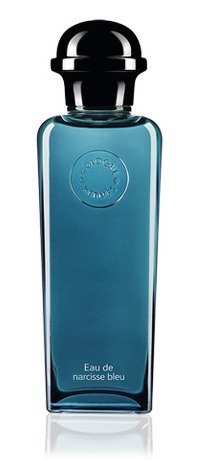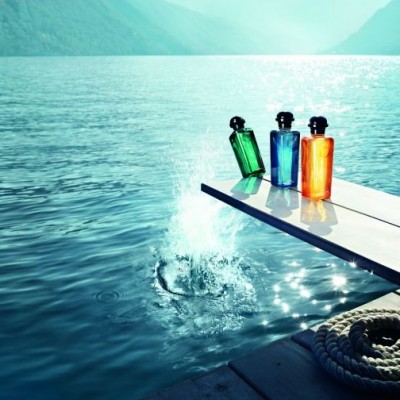Hermès Les Colognes Eau de Mandarine Ambrée & Eau de Narcisse Bleu (2013): Eaux d'Orange Bleue in a Diptyque {Perfume Reviews & Musings}

Schwebebahn (Cologne) by Fritz Gartner (1882–1958). 19th century.
The two latest colognes by Hermès, Eau de Mandarine Ambrée and Eau de Narcisse Bleu {See announcement}, are really, taken as a whole, a study in painterly contrasts and complementarity between a warm orange and a cold gray-blue. The two compositions are olfactorily speaking at the opposite end of each other as if they were chromatic illustrations of the theory of color which pair orange and blue as complementary shades to each other. We know that perfumer Jean-Claude Ellena is interested in painting and is himself an amateur watercolorist; it is therefore not mere happenstance if we are able to perceive these two fragrances as if they were a diptyque, the two sides of a large modernist painting structured around two blocks of frank, well-delineated color meant to strike together and not just separately...
There is moreover this myth about a blue orange popularized by Belgian cartoonist of Tintin, Hergé. And of course the poem by Paul Eluard in which he writes that "La Terre est bleue comme une orange" (Earth is blue like an orange).
As we look back, we have to remember also that the inaugural cologne in this series by Hermès whose purpose is to reinterpret the classic genre of the eau de cologne is Eau d'Orange Verte (1979), a cold impression thrust onto the warm scented tones of an orange fruit rendered like a bitter.
Eau de Mandarine Ambrée + Eau de Narcisse Bleu Surround in the Air
Smelled side by side, it becomes evident that that the original green orange has led more or less consciously to a blue-orange chromatic contrast, and somehow floating above, when the two are united, a blue orange takes shape.
We also know that it is customary for Jean-Claude Ellena to juxtapose for didactic purposes two scented paper blotters to his audience so as to derive a new accord from it, himself calling it his illusionist's trick.
This is what happens when you smell your two arms locked in an olfactory embrace: it is not just about an ambery and orangey mandarin on one side and a blue narcissus on the other. It becomes, more secretly but just as concretely, an Eau d'Orange Bleue or rather a combined, momentary fusion of Eaux d'Orange Bleue thanks to a logic and aesthetic of complementarity. Like the two Cs of Chanel, it locks the identity of the collection.

Eau de Mandarine Ambrée
In a sense, Eau de Mandarine Ambrée renews the sub-genre of the ambery eau de cologne.
Splashed on: a mandarin note predominates which is both round and brisk. The medium-light amber mellows the sensations which Ellena wanted to be "velvety" and he succeeds in creating a sense of polished roundness. What quickly becomes the main impression is a note of slightly furry ambergris and labdanum.
Sprayed on: the opening is much more that of a white, blanched citrus effect in the line of Eau d'Orange Verte whose bitterness has been rewoven into this thread. The overall impression is more complex while the fruity accent of passion fruit is better felt. The ambergris sings a better duet with the hesperides. The larger-picture effect is that of a fruity-floral with rather saltiney and seasidey nuances of warm ambergris. The formulation comes across as economical in its aesthetic design. The slightly dirty ambergris and labdanum remind you of Untitled by Martin Margiela but also Armani Acqua di Gioia.
We recommend spraying on this eau de cologne for maximum perfume-like impression and splashing on for a simpler, more minimalist effect. The more you spray on, the more depth it gains without ever becoming loud.
Overtime it melds beautifully with the skin with a very light powdery ambery impression gently subsiding on the skin like a more evanescent recall of Eau d'Ambre Extrême by l'Artisan Parfumeur, also by Ellena.

Eau de Narcisse Bleu
There once used to be a perfume by Mury in the 1920s called Le Narcisse Bleu. Its flacon has been reappropriated for Ombre Rose de Jean-Charles Brosseau. As one can see, it is a flower rarely addressed to in perfumery.
Splashed on: it smells of a rooty, floral, green composition (galbanum) with nuances of leeks that recall hyacinth. It interjects just the necessary touch of ugliness to come across as a bit standoffish. It makes for a rather dry and austere cologne showing the ascetic side of Jean-Claude Ellena's style.
Sprayed on: Again, the blanched citruses effect is more pronounced in this manner. A scent of chili pepper is also more perceptible. The floral accord is much more complex and variegated coming across as leafy, earthy and petaly like the scents around a chrysanthemum, with a balancing act maintained better between the floral nuance and the citrusy one. The drydown is green and severe. The spent stage of the drydown is iris-y and flour-y.
For this composition Ellena explicitly went for a special tactile effect which can be experienced innocently as a "dusty" effect. Is it as rugose as anticipated by its author, and consequently as novel a sensation as he hoped for, this remains debatable in my opinion.
Eau de Narcisse Bleu is a rooty, low-key floral hovering between hyacinth and iris, with a clean, ozonic nuance as well as veiled, misty ones suggestive of a forest.

Eau de Mandarine Ambrée + Eau de Narcisse Bleu onto the Skin
Ellena himself is not against layering perfumes, and in this case it works also if you layer the two colognes together onto the skin rather than creating a hologram in the air, but it gives a slightly different effect. it is less painterly and becomes more like a frozen, airy orange stuck in a glacier while the color veers towards green. Then, the two together come off as smokier and more difficult altogether but rather interesting. If you want to intrigue, this is the way to go although on the long run, the isolated drydown of Narcisse Bleu is more intriguing.
Jean-Claude Ellena said about the genre of the eau de cologne that "Colognes are those wellness products which elicit immediate pleasure and are also perfumes of intimacy which answer one's need for refinement and voluptuousness that one feels within oneself and for oneself. Classical, original, sometimes surprising, I've created them so that they were to be lived-in more than ostentatiously worn." Consequently, do not expect these eaux de cologne to shout and be faux colognes. They remain discreet trails.
The word "Eau" in their names is there for a reason, to remind us that when perfume attempts to emulate water, it has to choose between an empty metaphor or an experience as close as possible to reality. In this case, it is clear that the element water was taken seriously and given pride of place. One can feel its presence, like a perfumery note smelling a lot like real water and naturally diluting our sensations overtime.









